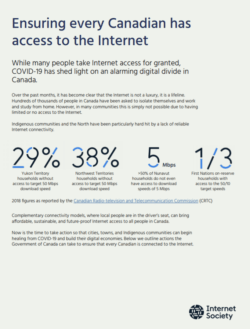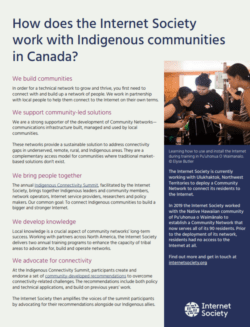Over the past months, it has become clear that the Internet is not a luxury, it is a lifeline. Hundreds of thousands of people in Canada have been asked to isolate themselves and work and study from home. However, in many communities this is simply not possible due to having limited or no access to the Internet.
Indigenous communities and the North have been particularly hard hit by a lack of reliable Internet connectivity.
29%: Yukon Territory households without access to target 50 Mbps download speed
38%: Northwest Territories households without access to target 50 Mbps download speed
5 Mbps: >50% of Nunavut households do not even have access to download speeds of 5 Mbps
1/3 First Nations on-reserve households with access to the 50/10 target speeds
2018 figures as reported by the Canadian Radio-television and Telecommunication Commission (CRTC)
Complementary connectivity models, where local people are in the driver’s seat, can bring affordable, sustainable, and future-proof Internet access to all people in Canada.
Now is the time to take action so that cities, towns, and Indigenous communities can begin healing from COVID-19 and build their digital economies. Below we outline actions the Government of Canada can take to ensure that every Canadian is connected to the Internet.
Make sure those that need access, right now, get it.
- Avoid massive, overly ambitious, and restrictive plans to deal with emergency access initiatives. Instead,prioritize streamlined application processes for micro-grants for community organizations.
- Establish an emergency fund specifically for non-profit and Indigenous service providers, recognizing the essential services they provide in rural and remote
- Immediately increase community subsidies for satellite dependent
- Call on shipping companies, including Canada Post, to prioritize delivery of telecommunications equipment.
Remove barriers to access.
- Extend open application deadlines for longer-term and large funding grants, such as the Broadband Fund and Connect to Innovate.
- Reassess funding program criteria to prioritize the communities most in need, and use a rolling application approval process to accelerate
- Fast track public permits to get middle-mile fibre to Indigenous communities while retaining community consultation requirements, especially with respect to ownership/control options/public
- Allow community organizations to match funds in-kind rather than in-cash when accessing funding grant programs.
- Allow flexibility in Indigenous communities where ‘traditional’ financing options are not
- Provide grant money up front, not through reimbursement, as many communities and organizations may not have the necessary working capital to complete preliminary engineering or other due diligence
- Accurate information about the availability, quality, community needs and priorities, and use (current and future) of Internet access in underserved areas is critical to the effective and efficient deployment of Internet infrastructure, particularly during a crisis like the COVID-19 pandemic. A broadband mapping system that more accurately portrays the availability of broadband in Canada will prove to be an essential tool to ensure no Canadians remain offline.
Make resources easier to access.
- Reallocate and/or set aside spectrum for small and regional Internet service providers, municipalities, Indigenous communities, and community networks in unserved or underserved areas (urban and rural) on a licensed, unlicensed, or shared/secondary use basis, particularly areas within licensed allotments that operators may not be using.
- Prioritize support for mesh networks in urban, underserved areas, and particularly those with large Indigenous populations such as Montreal, Ottawa, Toronto, Winnipeg, Edmonton, Vancouver, Yellowknife, and Whitehorse.
- Revise criteria for the 3500 MHz auction scheduled for 2020 to ensure priority access for municipal/ community networks.
- Revisit satellite ‘public benefit’ licensing rules to support deployment and provide capacity in underserved regions (for example, Canada’s territories and northern/remote regions of provinces).
We’re all part of building a bigger, stronger Internet.
How does the Internet Society work with Indigenous communities in Canada?
We build communities.
In order for a technical network to grow and thrive, you first need to connect with and build up a network of people. We work in partnership with local people to help them connect to the Internet on their own terms.
We support community-led solutions.
We are a strong supporter of the development of Community Networks— communications infrastructure built, managed and used by local communities.
These networks provide a sustainable solution to address connectivity gaps in underserved, remote, rural, and Indigenous areas. They are a complementary access model for communities where traditional market- based solutions don’t exist.
We bring people together.
The annual Indigenous Connectivity Summit, facilitated by the Internet Society, brings together Indigenous leaders and community members, network operators, Internet service providers, researchers and policy makers. Our common goal: To connect Indigenous communities to build a bigger and stronger Internet.
We develop knowledge.
Local knowledge is a crucial aspect of community networks’ long-term success. Working with partners across North America, the Internet Society delivers two annual training programs to enhance the capacity of tribal areas to advocate for, build and operate networks.
We advocate for connectivity.
At the Indigenous Connectivity Summit, participants create and endorse a set of community-developed recommendations to overcome connectivity-related challenges. The recommendations include both policy and technical applications, and build on previous years’ work.
The Internet Society then amplifies the voices of the summit participants by advocating for their recommendations alongside our Indigenous allies.

